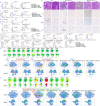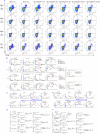Rab4A-directed endosome traffic shapes pro-inflammatory mitochondrial metabolism in T cells via mitophagy, CD98 expression, and kynurenine-sensitive mTOR activation
- PMID: 38519468
- PMCID: PMC10960037
- DOI: 10.1038/s41467-024-46441-2
Rab4A-directed endosome traffic shapes pro-inflammatory mitochondrial metabolism in T cells via mitophagy, CD98 expression, and kynurenine-sensitive mTOR activation
Abstract
Activation of the mechanistic target of rapamycin (mTOR) is a key metabolic checkpoint of pro-inflammatory T-cell development that contributes to the pathogenesis of autoimmune diseases, such as systemic lupus erythematosus (SLE), however, the underlying mechanisms remain poorly understood. Here, we identify a functional role for Rab4A-directed endosome traffic in CD98 receptor recycling, mTOR activation, and accumulation of mitochondria that connect metabolic pathways with immune cell lineage development and lupus pathogenesis. Based on integrated analyses of gene expression, receptor traffic, and stable isotope tracing of metabolic pathways, constitutively active Rab4AQ72L exerts cell type-specific control over metabolic networks, dominantly impacting CD98-dependent kynurenine production, mTOR activation, mitochondrial electron transport and flux through the tricarboxylic acid cycle and thus expands CD4+ and CD3+CD4-CD8- double-negative T cells over CD8+ T cells, enhancing B cell activation, plasma cell development, antinuclear and antiphospholipid autoantibody production, and glomerulonephritis in lupus-prone mice. Rab4A deletion in T cells and pharmacological mTOR blockade restrain CD98 expression, mitochondrial metabolism and lineage skewing and attenuate glomerulonephritis. This study identifies Rab4A-directed endosome traffic as a multilevel regulator of T cell lineage specification during lupus pathogenesis.
© 2024. The Author(s).
Conflict of interest statement
The authors declare no competing interests.
Figures









References
-
- Mihara M, et al. Immunologic abnormality in NZB/NZW F1 mice. Thymus-independent occurrence of B cell abnormality and requirement for T cells in the development of autoimmune disease, as evidenced by an analysis of the athymic nude individuals. J. Immunol. 1988;141:85–90. doi: 10.4049/jimmunol.141.1.85. - DOI - PubMed
MeSH terms
Substances
Grants and funding
LinkOut - more resources
Full Text Sources
Medical
Molecular Biology Databases
Research Materials
Miscellaneous

